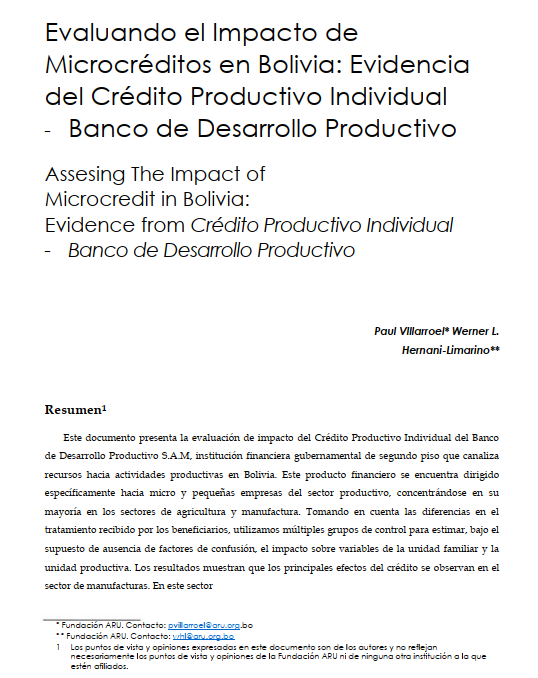Evaluating Impact of Microcredit in Bolivia: Evidence of Individual Productive Credit – Productive Development Bank
DOI:
https://doi.org/10.35319/lajed.20150377Keywords:
Impact evaluation, microcredits, microfinanceAbstract
This paper presents the impact evaluation of Crédito Productivo Individual from Banco de Desarrollo Productivo S.A.M, government secondtier bank which channels resources toward productive activities in Bolivia. This financial product is specifically directed to micro and small enterprises in the productive sector, concentrating mosdy in the agriculture and manufacturing. Taking into account differences in treatment received by beneficiaries, we use multiple control groups, assuming unconfoundedness, to estimate impact on family and production outcomes. The results show us that the main effects of credit are observed in manufacturing sector. In this sector we find an impact between 23% and 28% on machinery investment levels, which could be the explanation for an observed impact higher than 20% on production value. On the other hand, we only find effects in reducing input costs, suggesting that the greatest impact in the agricultural sector could be the opening of financial products to this group of producers.Downloads
References
Abadie A., Imbens G. (2002). Simple and Bias-Corrected Matching Estimators for Average Treatment Effects, Documento técnico T0283, NBER.
Abadie, A., Imbens G. (2006). Large Sample Properties of Matching Estimators for Average Treatment Effects, Econometrica, 74(1), 235-267.
Armendáriz de Aghion B., Morduch J. (2005), The economics of microfinance, Cambridge: MIT Press.
Banco de Desarrollo Productivo - BDP S.A.M. (2008). Reglamento del fideicomiso para el desarrollo productivo - FDP, 27 de Noviembre.
Banco de Desarrollo Productivo - BDP S.A.M. (2008). Resolución de directorio 21/2008, 27 de Noviembre.
Banerjee A., Duflo E., Glennerster R., Kinnan C. (2009), The miracle of microfinance? Evidence from a randomised evaluation.
Coleman, B. (1999). The impact of microcredit lending in northeast Thailand, Journal of Development Economics, 60(1): 105-141.
Dunn E., Arbuckle J. (2001). The impacts of microcredit: a case study from Peru. Reporte sustrico a USAID evaluando el impacto de servicios a microempresas (AIMS), Septiembre.
Dunn E. (2005). Impacts of microredit in clients in Bosnia and Herzegovina, Presentado a Foundation for Sustainable Development of the Federation of Bosnia and Herzegovina y Republika Srpska Development and Employment Foundation.
Gobierno del Estado Plurinacional de Bolivia (2007). Decreto Supremo Nº29145, 30 de Mayo.
Gonzales-Vega C. Schreiner M., Meyer R. Rodriguez J. Navajas S. (1996). BANCOSOL The challenge of growth for microfinance organizations, Rural Finance Program, Departamento de Economía Agrónoma, Universidad Estatal de Ohio.
Gonzales-Vega C. Schreiner M., Meyer R. Rodriguez J. Navajas S., Monje G. (1996). Microfinance market niches and client profiles in Bolivia, Rural Finance Program, Departamento de Economía Agrónoma, Universidad Estatal de Ohio.
Horovitz D., Thompson D. (1952). A Generalization of Sampling Without Replacement from a Finite Universe, Journal of the American Statistical Association, 47, 663-685.
Hossain, M. (2001), Credit for alleviation of rural poverty: The Grameen Bank in Bangladesh, International Food Pilicy Research Institute y Bangladesh Institute of Development Studies.
Karlan D. Zinman J. (2008). Expanding credit access: Using randomized supply decisions to estimate the impacts, Review of Financial Studies, 23(1): 433-464.
Maldonado J., Gonzales-Vega C., Romero V. (2003). The influence of microfinance on the education decisions of rural hoseholds: Evidence from Bolivia, Documento preparado para la presentación en el encuentro anual de la Asociación Americana de Economistas Agrónomos, Julio.
MkNelly B., Lippold K. (1998). Practitioner-led impact assessment: A test in Mali, Reporte suscrito a USAID evaluando el impacto de servicios a microempresas (AIMS).
Morduch J. (1998), Does microfinance really help the poor? New evidence from flagship programmes in Bangladesh.
Navajas S., Schreiner M. (1998). APEX organizations and the growth of microfinance in Bolivia, Reporte Preparado para CGAP-OSU Research Project on Microfinance Apex Mechanisms, Rural Finance Program, Departamento de Economía Agrónoma, Universidad Estatal de Ohio.
Pitt MM, Khandker SR. (1998), The impact of grupo-based credit programmes on poor households in Bangladesh: does the gender of participants matter?, Journal of Political Economy, 106(5): 958996.
Rubin (1973). The Use of Matched Sampling and Regression Adjustments of Remove Bias in Observational Studies, Biometrics, 29, 185-203.
Schreiner M. (1999). A scoring model of the risk of costly arrears at a microfinance lender in Bolivia, Microfinance Risk Managment y Center of Social Development Washington Univerity in St. Louis.
Stewart R, van Rooyen C, Dickson K, Majoro M, de Wet T. (2010), What is the impact of microfinance on poor people? A systematic review of evidence from sub-Saharan Africa, Reporte técnico, EPPI-Centre, Social Science Research Unit, Universidad de London.
Vogelgesang U. (2001). Investing microfinance: Caja Los Andes, Bolivia, Serie de Documentos de trabajo no. 2001-01, University of Mannheim.
Wooldridge J. (2007). Inverse Probability Weihted M-Estimators for General Missing Data Problem, Journal of Econometrics.






